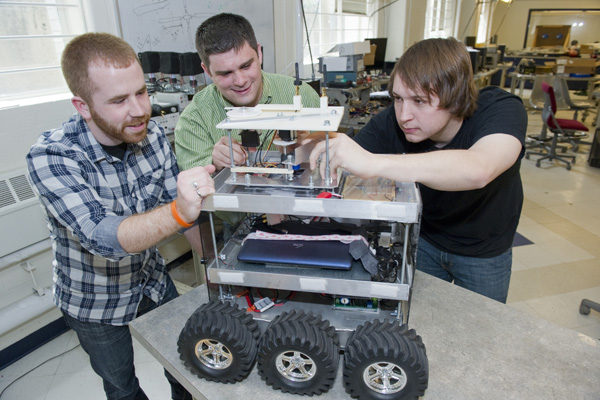Roving robot to the rescue

Northeastern University student-researchers have created a roving robot named WiLU that may be able to locate and rescue victims of natural disasters or participate in military missions that are too dangerous for soldiers.
The innovative technology was developed for a senior capstone project under the direction of electrical and computer engineering professor Charles DiMarzio and associate professor in the College of Computer and Information Science, Guevara Noubir. The team members included electrical and computer engineering students Tom Bottiglieri, Spiros Mantzavinos, Travis Taylor, Ryan Whelan and Eric Williams.
WiLU—which looks like a Tonka truck—could help save the lives of victims of catastrophic disasters, such as the massive 9.0 earthquake that rocked Japan in March, said Whelan.
As he put it, “You could send this robot into a search and rescue scenario where you don’t want humans to go.”
Noubir sponsored the students and funded the project with a portion of the National Science Foundation (NSF) Major Research Instrumentation grant awarded to him and an interdisciplinary team of professors from Northeastern to develop wireless sensor networks that support key applications such as search and rescue by swarms of robots.
He praised the student’s innovative robot. “It’s a great example of an effective research platform that integrates multi-disciplinary expertise spanning mechanical engineering, RF communications, embedded software development, and algorithms designs.”
Students created a complex algorithm that would enable the robot to locate people—or even bombs that are detonated through mobile phones.
Here’s how it works: a smart antenna mounted atop WiLU measures the signal strength of a mobile phone that is connected to a wireless network. Then, the robot autonomously determines the location of the object by adaptively forming beams to pinpoint the direction and location of the wireless signal source.
Students, who say humans could also control the robot from remote locations, hope to create a subscription service whereby mobile phone users could automatically join the WiFi network.
“Incorporating so many different creative and technical skills on a single project is the goal of our Capstone Design course,” DiMarzio said.




